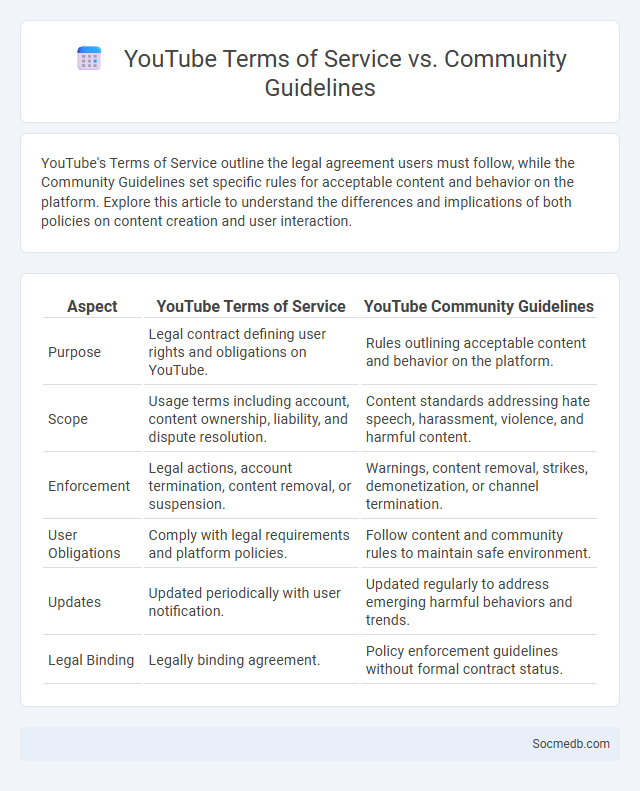
Photo illustration: YouTube Terms of Service vs Community Guidelines
YouTube's Terms of Service outline the legal agreement users must follow, while the Community Guidelines set specific rules for acceptable content and behavior on the platform. Explore this article to understand the differences and implications of both policies on content creation and user interaction.
Table of Comparison
| Aspect | YouTube Terms of Service | YouTube Community Guidelines |
|---|---|---|
| Purpose | Legal contract defining user rights and obligations on YouTube. | Rules outlining acceptable content and behavior on the platform. |
| Scope | Usage terms including account, content ownership, liability, and dispute resolution. | Content standards addressing hate speech, harassment, violence, and harmful content. |
| Enforcement | Legal actions, account termination, content removal, or suspension. | Warnings, content removal, strikes, demonetization, or channel termination. |
| User Obligations | Comply with legal requirements and platform policies. | Follow content and community rules to maintain safe environment. |
| Updates | Updated periodically with user notification. | Updated regularly to address emerging harmful behaviors and trends. |
| Legal Binding | Legally binding agreement. | Policy enforcement guidelines without formal contract status. |
Introduction to YouTube’s Policies
YouTube's policies are designed to create a safe and positive environment for users by regulating content related to copyright, hate speech, and misinformation. These guidelines include rules on community standards, monetization eligibility, and content strikes to enforce compliance. Understanding YouTube's policies is essential for creators to maintain channel integrity and avoid penalties or content removal.
Overview of YouTube Terms of Service
YouTube Terms of Service govern user conduct, content ownership, and platform usage policies, ensuring compliance with copyright laws and community guidelines. Users grant YouTube a worldwide license to host, distribute, and display uploaded content while retaining ownership rights. Violations of these terms can lead to account suspension or removal of content to maintain a safe and legal environment.
What Are YouTube Community Guidelines?
YouTube Community Guidelines are a set of rules and policies designed to maintain a safe and positive environment for all users on the platform. They cover content restrictions such as prohibiting hate speech, harassment, misinformation, and harmful or dangerous acts. Understanding these guidelines helps ensure your videos comply with YouTube's standards, protecting your channel from strikes or removal.
Demonetization: Definition and Implications
Demonetization on social media refers to the removal or restriction of a creator's ability to earn revenue from their content, often triggered by violation of platform policies or changes in algorithms. This practice impacts content creators by limiting their income streams, affecting both established influencers and emerging talent, which can lead to reduced content diversity and creativity. Platforms like YouTube and Facebook utilize demonetization to enforce community standards and advertiser-friendly content guidelines, influencing monetization strategies across the digital ecosystem.
Key Differences: Terms of Service vs Community Guidelines
Terms of Service define the legal contract between users and the platform, outlining rights, responsibilities, and consequences for violations, while Community Guidelines offer behavioral standards to foster safe and respectful interaction. Platforms like Facebook and Twitter enforce Terms of Service for account security and data protection, whereas Community Guidelines address content moderation, hate speech, and harassment. Understanding both is crucial for users to navigate compliance and maintain positive engagement on social media networks.
How Violations Lead to Demonetization
Violations of social media platform policies, such as posting copyrighted content without permission or spreading misinformation, result in demonetization by restricting or eliminating your ability to earn revenue. These breaches trigger automated detection systems or manual review processes that enforce penalties to maintain content quality and community standards. Content creators must adhere to guidelines to protect their monetization status and sustain their income streams.
Common Reasons for TOS and Guidelines Breaches
Common reasons for Terms of Service (TOS) and guidelines breaches on social media include posting inappropriate content, such as hate speech, violence, or explicit material, as well as spreading misinformation or engaging in harassment and bullying. Violations often stem from sharing copyrighted material without permission or manipulating platform features to create fake engagement. Ensuring Your content aligns with community standards helps maintain a positive experience and reduces the risk of account suspension or removal.
Navigating YouTube’s Enforcement Actions
YouTube's enforcement actions include content removal, strikes, and account suspensions to maintain platform guidelines. Understanding YouTube's Community Guidelines and copyright policies helps you avoid violations and protect your channel. Efficiently navigating these rules ensures your content remains compliant and your channel active.
Best Practices to Avoid Violations and Demonetization
To avoid social media violations and demonetization, you must adhere strictly to platform guidelines, including community standards and content policies. Consistently use original content, avoid hate speech, misinformation, and copyright infringement to maintain your channel's monetization eligibility. Regularly review updates from platforms like YouTube, Instagram, and Facebook to ensure your content practices align with their evolving rules.
Conclusion: Protecting Your Channel and Revenue
Securing your social media channel is essential to safeguard your revenue streams and maintain brand integrity. Implement robust security measures such as two-factor authentication, regular access audits, and content monitoring to prevent unauthorized access or attacks. Protecting your channel ensures continuous engagement with your audience and stable income generation from your digital presence.
 socmedb.com
socmedb.com